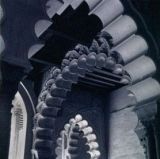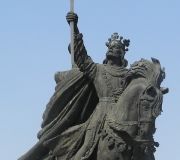Back to Timelines

Córdoban Ulama Formally Dissolve the Caliphate

Abd Allah ibn Yasin Attracts Berber Converts

Religious reformer Abd Allah ibn Yasin attracts Berber converts and founds a ribat (fortified retreat) in the Sahara, which becomes the base for the Almoravid movement in North Africa. Ferdinand I of Castile-León, like his father Sancho III, claims the title, “Emperor of All Spains.” The Jewish wazir (minister), Samuel Ha-Nagid, leads the Muslim Zirid army of Granada in several battles against the forces of the Abbadid kingdom of Seville. Other taifa states (petty kingdoms) vie with each other, as well.
Scholar Ali Ibn Hazm Produces Numerous Writings

Scholar Ali Ibn Hazm, having renounced political service, produces numerous theological, legal, and moralistic writings, in addition to the Tawq al-Hamamah (“The Dove’s Necklace”), a compendium of humorous observations about love and human nature. At Zaragosa, Solomon ibn Gabirol composes Judeo-Arabic poetry, a famous moral treatise, and the Meqor Hayyim (“The Fountain of Life”), a philosophical work that influenced Christian scholastic debates in 13th century Europe.
Pope Alexander II Sends a Force Against the Muslim-held Fortress of Barbastro

Pope Alexander II sends a combined force of Italian, Norman, French, and Spanish knights against the Muslim-held fortress of Barbastro in the north, massacring many inhabitants and enslaving the rest. The Almoravid leader, Yusuf ibn Tashufin, founds the capital city of Marrakesh and begins expanding his empire northward throughout Morocco and Algeria.
Abu Ishaq Rebukes the Berber Rulers

Granadan scholar Abu Ishaq writes a lengthy poem rebuking the Berber rulers of the city and accusing the wazir, Joseph Ha-Nagid, of having too much political influence. His followers kill the wazir and massacre several hundred Jews in Granada.
Castilians Under Sancho II and Rodrigo Díaz (El Cid) Defeat the Leónese

The Castilians under Sancho II and Rodrigo Díaz (El Cid) defeat the Leónese. Alfonso VI of León leads a campaign against Muslim Badajoz, a province of western Spain, but withdraws when the amir, Mamun of Toledo, intercedes.
al-Mu’tamid, the Amir of Seville, Agrees to Pay a Tribute

The Berber Zirid rulers of Granada reject a Castilian demand for tribute, but al-Mu’tamid, the amir of Seville, agrees to pay. A joint Muslim-Castilian force makes raids in the region of Granada. Muslim Toledo takes control of Córdoba from Seville with the help of Castilian troops.
Rulers of Zaragosa Build the Aljafería Fortress and Palace

The Banu Hud rulers of Zaragosa build the Aljafería fortress and palace. Rodrigo Díaz (El Cid) becomes a mercenary after being exiled by Alfonso IV of Castile. El Cid enters the service of the Muslim rulers of Zaragosa. At the Battle of Almenar in 1082, El Cid’s Zaragosan forces defeat the combined Muslim-Christian army of Valencia, Lerida, Aragón, and Barcelona.
Alfonso VI of León-Castile Takes Control of Toledo

Alfonso VI of León-Castile takes control of Toledo, where he once sought refuge under the Muslim king, Mamun, from his brother Sancho, and claims the title of “Emperor of All Spains.” Alfonso supports the translation of Arabic scientific works into Latin and permits six parishes in the city to continue to use the Mozarabic Christian rite. Muslim inhabitants form one of the earliest Mudejar communities living under Christian rule.
Taifa Rulers Invite Yusuf ibn Tashufin To Al-Andalus

The taifa rulers, Ibn Buluggin of Granada and Al-Mu’tamid of Seville, invite the Almoravid leader, Yusuf ibn Tashufin, to Al-Andalus to prevent further losses to the Christians. The Almoravids defeat Alfonso VI’s forces at the Battle of Zallaqa. Several years later, ibn Tashufin returns to take control of numerous taifa states and exiles their rulers. Al-Andalus is incorporated into the large Berber Empire, based in North Africa.




